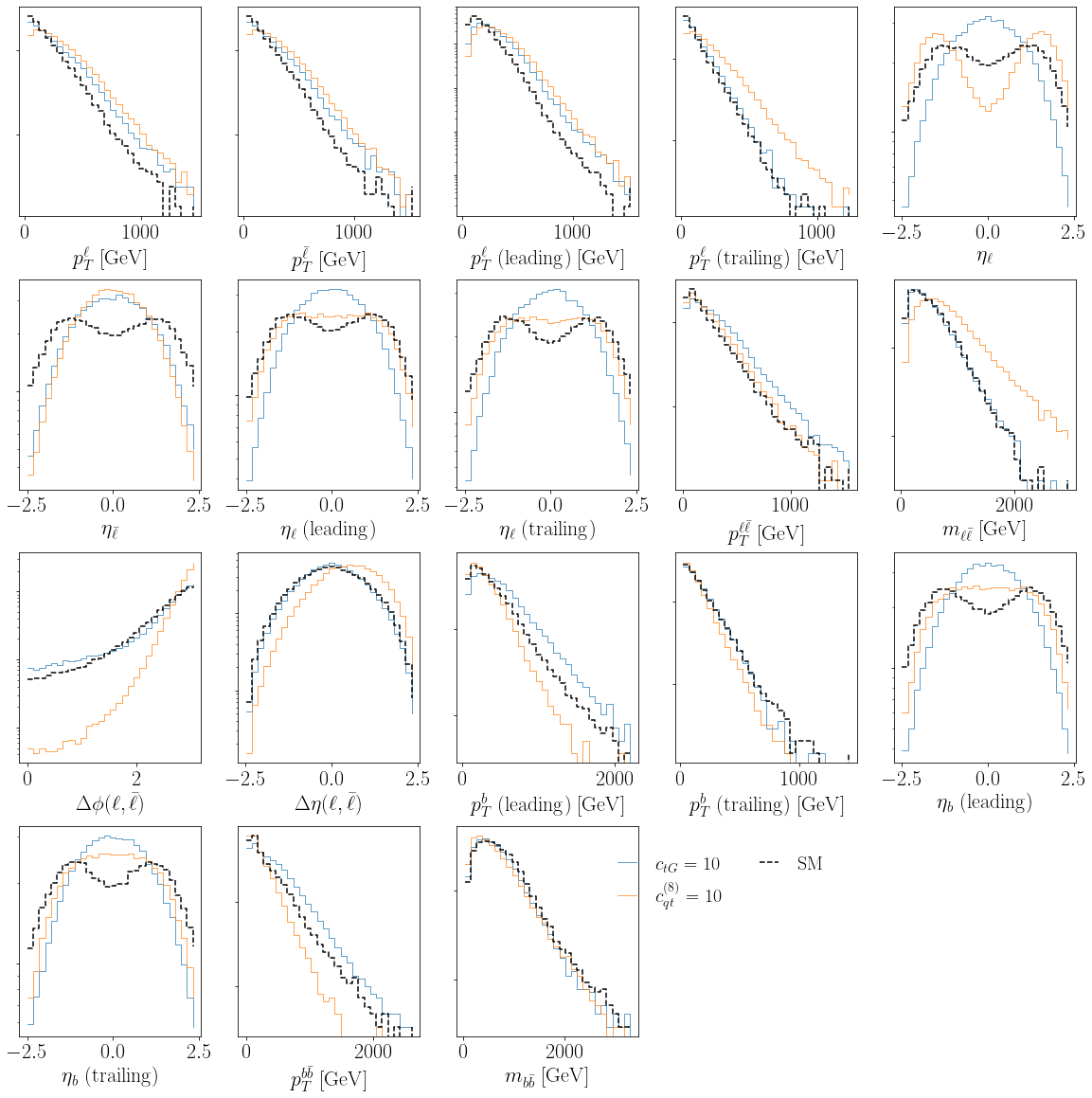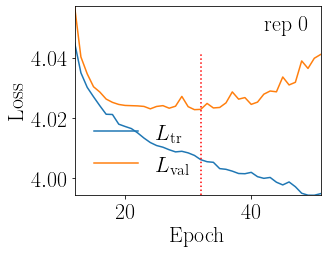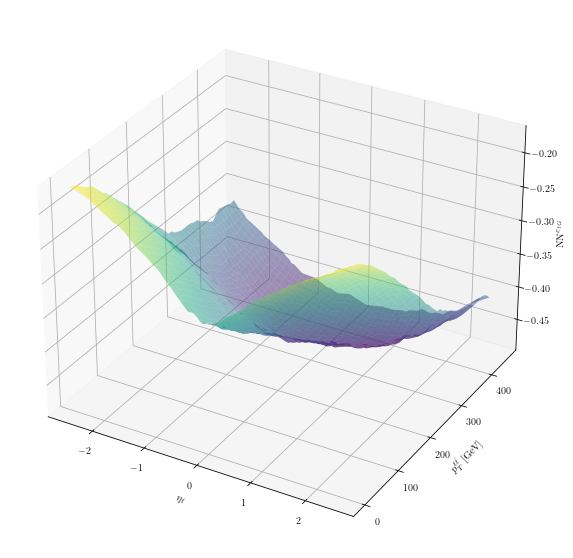Tutorial
Contents
Tutorial#
Learning unbinned observables#
The goal of this tutorial is to demonstrate and to give a handle on how to obtain unbinned multivariate observables from machine learning. We do this by considering inclusive top quark pair production at the particle level i.e. including top quark decays in the dilepton channel: \(p p \rightarrow t \bar{t}, t \bar{t} \rightarrow b \bar{b} \ell^{+} \ell^{-} \nu_{\ell} \bar{\nu}_{\ell}\), at the LHC 14 TeV as an example. We focus on the following two dimension-six operators that modifiy top-quark pair production:
where
The ML4EFT method generalises to an abritrary number of operators, but for the purpose of this tutorial we focus on the two operators defined above. We will parameterise the likelihood ratio (EFT over SM) using models that have either been trained on a pair of features, or on the full set of kinematic features available in the final state at the particle level. Since the actual training takes a bit of time, especially when working on a single core, we provide pretrained models that can be loaded and analysed directly. However, we do give instructions on how to train models yourself in the first part of this tutorial applied in a simplified setup.
The likelihood ratio, denoted \(r(x, c)\), takes the following form in the presence of \(\mathcal{O}_{tG}\) and \(\mathcal{O}_{tq}^{(8)}\):
where \(\boldsymbol{x}\) denotes the kinematic feature vector, e.g \((p_T^{\ell\bar{\ell}}, \eta_\ell)\), corresponding to the transverse momentum of the lepton-pair and the pseudorapidity of the lepton respectively.
The first part of this tutorial shows how to load and study the distribution of the training data, while the second part is about training unbinned observables in the presence of \(p_T^{\ell\bar{\ell}}\) and \(\eta_\ell\). We will finish by showing how this method generalises to the fully multivariate analysis that we trained on 18 features.
Installing ML4EFT#
To install ML4EFT, if not done already, one should run the following command:
[ ]:
!pip install ml4eft
When running this notebook on google colab, please make sure to execute the cell below to enable interactive plotting. Currently, the default version of matplotlib might lead to some errors on google colab for some users. In that case we advise to simply rerun all cells.
[ ]:
!pip install ipympl
from google.colab import output
output.enable_custom_widget_manager()
Loading the training data#
[ ]:
import wget
import tarfile
import os
import time
import numpy as np
import pandas as pd
import matplotlib.pyplot as plt
from matplotlib import rc
import ml4eft.core.classifier as classifier
import ml4eft.analyse.analyse as analyse
import ml4eft.plotting.features as features
rc('text', usetex=False)
rc('font', **{'family': 'DejaVu Sans', 'size': 22})
We define two helper functions that serve to download and untar remote files:
[2]:
def file_downloader(url, download_dir='./downloads'):
if not os.path.exists(download_dir):
os.mkdir(download_dir)
file = wget.download(url, out=download_dir)
return file
def untar(path_to_tar, destination='./downloads'):
with tarfile.open(path_to_tar) as f:
f.extractall(destination)
download_dir = './downloads'
For simplicity, we will focus on a single replica here, but the method can be easily applied to \(n_{\mathrm{rep}} > 1\) replicas in case one has a cluster available. Training data can be downloaded as follows and contains 100K events with 18 particle level features each:
[ ]:
training_data_url = 'https://dl.dropboxusercontent.com/s/z16fz2ggbn244pl/training_data.tar.gz?dl=0'
training_data = file_downloader(training_data_url);
data_train_loc = training_data.split('.tar')[0]
untar(training_data);
The events are stored as pandas dataframes that we will now load
[4]:
# load eft events
coeff = ["ctGRe", "ctj8"]
events_eft = []
for c in coeff:
path_to_events = os.path.join(data_train_loc, 'tt_{}_{}/events_0.pkl.gz'.format(c, c))
events, xsec = analyse.Analyse.load_events(path_to_events)
events_eft.append(events)
# load sm events
events_sm, xsec_sm = analyse.Analyse.load_events(os.path.join(download_dir, 'training_data/tt_sm/events_0.pkl.gz'))
Let us plot the distribution of the training we have just loaded. We will plot the SM and the SM complemented with quadratic corrections induced by \(\mathcal{O}_{tG}\) and \(\mathcal{O}_{tq}^{(8)}\). The cell directly below is just for plotting purposes to denote the axes and legend labels.
[5]:
feature_dict = {'pt_l1': r'$p_T^{\ell}\;[\mathrm{GeV}]$',
'pt_l2': r'$p_T^{\bar{\ell}}\;[\mathrm{GeV}]$',
'pt_l_leading': r'$p_T^{\ell}\;(\mathrm{leading})\;[\mathrm{GeV}]$',
'pt_l_trailing': r'$p_T^{\ell}\;(\mathrm{trailing})\;[\mathrm{GeV}]$',
'eta_l1': r'$\eta_\ell$',
'eta_l2': r'$\eta_{\bar{\ell}}$',
'eta_l_leading': r'$\eta_\ell\;(\mathrm{leading})$',
'eta_l_trailing': r'$\eta_\ell\;(\mathrm{trailing})$',
'pt_ll': r'$p_T^{\ell\bar{\ell}}\;[\mathrm{GeV}]$',
'm_ll': r'$m_{\ell\bar{\ell}}\;[\mathrm{GeV}]$',
'DeltaPhi_ll': r'$\Delta\phi(\ell, \bar{\ell})$',
'DeltaEta_ll': r'$\Delta\eta(\ell, \bar{\ell})$',
'pt_b_leading': r'$p_T^{b}\;(\mathrm{leading})\;[\mathrm{GeV}]$',
'pt_b_trailing': r'$p_T^{b}\;(\mathrm{trailing})\;[\mathrm{GeV}]$',
'eta_b_leading': r'$\eta_{b}\;(\mathrm{leading})$',
'eta_b_trailing': r'$\eta_{b}\;(\mathrm{trailing})$',
'pt_bb': r'$p_T^{b\bar{b}}\;[\mathrm{GeV}]$',
'm_bb': r'$m_{b\bar{b}}\;[\mathrm{GeV}]$'
}
legend_labels = [r'$c_{tG}=10$', r'$c_{qt}^{(8)}=10$', r'$\mathrm{SM}$']
[6]:
fig = features.plot_features(events_sm, events_eft, feature_dict, legend_labels);

Looking at the distribution of the 18 features plotted above, we notice some clear departures away from the SM in nearly all kinematic features. We thus expect a full multivariate analysis to pay off compared to a simple binned analysis in one or two kinematics. The latter is also inherently bound by the curse of dimensionality: a binned analysis would require populating a 18-dim feature space through Monte Carlo, which is simply impossible since the number of simulated events required to populate a 18-dim feature space scales exponentially with the number of dimensions!
Training unbinned observables#
Having loaded the training data, we now move on to the actual training part of this introductory tutorial. To this end, we download a training runcard that contains information regarding the setup, such as the architecture, number of mini-batches, epochs and data points, etc…
[7]:
path_to_runcard = 'https://dl.dropboxusercontent.com/s/v4ulo6icveh63fw/run_card_tt_llvlvlbb.json?dl=0'
runcard = file_downloader(path_to_runcard)
100% [..............................................................] 781 / 781
Let us open the training runcard to see the possible options that can be set
[8]:
import json
with open(runcard) as json_runcard:
json_runcard_loaded = json.load(json_runcard)
json_runcard_loaded
[8]:
{'process_id': 'tt',
'epochs': 2000,
'lr': 0.0001,
'n_batches': 50,
'output_size': 1,
'hidden_sizes': [100, 100, 100],
'n_dat': 100000,
'event_data': './downloads/training_data/',
'features': ['pt_l1',
'pt_l2',
'pt_l_leading',
'pt_l_trailing',
'eta_l1',
'eta_l2',
'eta_l_leading',
'eta_l_trailing',
'pt_ll',
'm_ll',
'DeltaPhi_ll',
'DeltaEta_ll',
'pt_b_leading',
'pt_b_trailing',
'eta_b_leading',
'eta_b_trailing',
'pt_bb',
'm_bb'],
'loss_type': 'CE',
'scaler_type': 'robust',
'patience': 200,
'val_ratio': 0.2,
'c_train': {'cQd8': 10,
'cQj18': 10,
'cQj38': 10,
'cQu8': 10,
'ctd8': 10,
'ctGRe': -10,
'ctj8': 10,
'ctu8': 10}}
The features on which we would like to train can be specified after the features key. We will train on all available features and keep it as it is. Feel free to change the settings, for instance by following the syntax below
[9]:
json_runcard_loaded['epochs'] = 200
json_runcard_loaded['lr'] = 0.001
json_runcard_loaded['n_batches'] = 50
json_runcard_loaded['patience'] = 20 # needs to be bigger than number of epochs
In case you have modified some settings, it is important to write them back to the original file:
[10]:
with open(runcard, 'w') as runcard_updated:
json.dump(json_runcard_loaded, runcard_updated)
Once you are happy with the settings, the training can be launched as
[ ]:
output_dir = './models'
c_name = 'ctGRe'
fitter = classifier.Fitter(json_path = runcard,
mc_run = 0,
c_name = c_name,
output_dir = output_dir,
print_log=True)
In this runcard, mc_run specifies the replica number (must match with events_<mc_run>.pkl.gz), and c_name denotes the NN that will be trained. Possible options here are for instance ctGRe_ctGRe, ctj8_ctj8 in case of a quadratic coefficient function, or ctGRe in case one wants to train the linear term in the likelihood ratio accomponying \(c_{tG}\).
Loading models#
Trained models can be loaded into an Analyse object to make them accesible for later use
[12]:
path_to_models_root = os.path.join('./models', time.strftime("%Y/%m/%d"))
order = 'lin' # or quad when quadratic models have been trained
models_paths_dict = analyse.Analyse.build_path_dict(root=path_to_models_root,
order=order,
prefix='model')
analyser = analyse.Analyse(models_paths_dict, order, all=True)
The loss profile of the models we have just trained can be plotted via
[18]:
fig, _ = analyser.plot_loss_overview(c_name, order, xlim=12)

Pretrained models#
Since properly training models takes a bit of time, we have provided a set of pretrained models that can be directly loaded and analysed. We consider the 2 feature case applied to \(p_T^{\ell\bar{\ell}}\) and \(\eta_\ell\) first.
[ ]:
models_2_feat_url = 'https://dl.dropboxusercontent.com/s/dy7ni8t4g8x68u0/tt_particle_ptll_etal.tar.gz?dl=0'
pretrained_models_2_feat = file_downloader(models_2_feat_url);
untar(pretrained_models_2_feat, destination='./downloads/models/tt_llvlvlbb_2_feat');
Like before, we load the models into a Analyse object:
[20]:
path_to_models_2_feat_root = './downloads/models/tt_llvlvlbb_2_feat'
order = 'quad'
models_paths_dict_2_feat = analyse.Analyse.build_path_dict(root=path_to_models_2_feat_root,
order=order,
prefix='model')
analyser_2_feat = analyse.Analyse(models_paths_dict_2_feat, order)
Given some “observed” data (not used during training) drawn from the SM, we can evaluate the NNs on this data through the following syntax:
[ ]:
observed_data_url = 'https://dl.dropboxusercontent.com/s/igjt97vfaxdn9y1/events_0.pkl.gz?dl=0'
observed_data = file_downloader(observed_data_url, './downloads/observed_data');
events_sm, _ = analyse.Analyse.load_events('./downloads/observed_data/events_0.pkl.gz')
# evaluate pretrained NNs on observed data
analyser_2_feat.evaluate_models(events_sm)
The output of all NN replicas for all coefficients is stored inside a pandas dataframe that can be called like
[22]:
models_evaluated_2_feat = analyser_2_feat.models_evaluated_df;
To see for instance the output associated to the NN associated to \(c_{tG}\) at the linear level, one can run
[23]:
models_evaluated_2_feat['models']['lin', 'ctGRe'];
Let us finally plot the (median) \(\mathrm{NN}^{c_{tG}}\) as a 2-dimensional surface in the 2-dim feature space \((p_{T}^{\ell, \bar{\ell}}, \eta_\ell)\):
[24]:
# create the 2-dim grid in feature space
eta_l_span = np.linspace(-2.5, 2.5, 100)
pt_ll_span = np.linspace(0, 450, 50)
eta_l_grid, pt_ll_grid = np.meshgrid(eta_l_span, pt_ll_span)
grid = np.c_[eta_l_grid.ravel(), pt_ll_grid.ravel()]
df = pd.DataFrame({'pt_ll': grid[:, 1], 'eta_l1': grid[:, 0]})
# evaluate the NNs on this grid and
analyser_2_feat.evaluate_models(df)
models_evaluated = analyser_2_feat.models_evaluated_df['models']
analyser_2_feat.models_evaluated_df['models'] = models_evaluated.apply(lambda row: np.median(row, axis=0))
nn_ctG = analyser_2_feat.models_evaluated_df['models']['lin', 'ctGRe'].reshape(eta_l_grid.shape)
[25]:
# make a 3D interactive plot
%matplotlib ipympl
fig = plt.figure(figsize=(10,10))
ax = plt.axes(projection='3d')
ax.set_xlabel(r'$\eta_\ell$')
ax.set_ylabel(r'$p_T^{\ell\bar{\ell}}\;\mathrm{[GeV]}$')
ax.set_zlabel(r'$\mathrm{NN}^{c_{tG}}$')
ax.plot_surface(eta_l_grid, pt_ll_grid, nn_ctG, cmap='viridis', alpha=0.5)
[25]:
<mpl_toolkits.mplot3d.art3d.Poly3DCollection at 0x7fc682f24d90>

18 features#
The fully multivariate models are also available, and can be loaded exactly like before
[ ]:
# download the models
models_18_feat_url = 'https://dl.dropboxusercontent.com/s/54uchr1w7pkjrqf/tt_particle_18_feat.tar.gz?dl=0'
pretrained_models_18_feat = file_downloader(models_18_feat_url);
untar(pretrained_models_18_feat, destination='./downloads/models/tt_llvlvlbb_18_feat');
[ ]:
# load the models
path_to_models_18_feat_root = './downloads/models/tt_llvlvlbb_18_feat'
order = 'quad'
models_paths_dict_18_feat = analyse.Analyse.build_path_dict(root=path_to_models_18_feat_root,
order=order,
prefix='model')
analyser_18_feat = analyse.Analyse(models_paths_dict_18_feat, order)
[ ]:
# evaluate pretrained NNs on observed data
analyser_18_feat.evaluate_models(events_sm)
[ ]:
analyser_18_feat.models_evaluated_df;
[ ]:
models_evaluated_18_feat = analyser_18_feat.models_evaluated_df['models']
[ ]:
models_evaluated_18_feat['lin', 'ctGRe'];